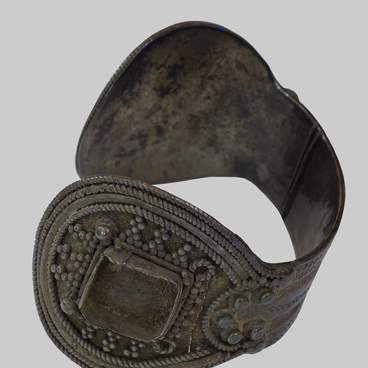The ChUpino treasure weighing one kilo and hundred grams was submitted to the BereznikI Museum in 1959. It consisted of a silver bracelet of the 12-13 centuries, two neck torqs and a fragment of a silver bowl.
The torq of the so-called ‘glazov’ type is a pectoral, which is round in cross-section rods. The ends of the rod are screwed and the central part is smooth. The torq, like the bracelet from the treasure, was presumably made by the craftsmen from the Volga Bulgaria.
But the shape and floral ornament of the bowl prove its Khwarazm origin. Khwarazm is an ancient state in Central Asia on the territory of modern Turkmenistan and Uzbekistan, through which the Great Silk Road passed. The culture of Khwarazm was formed already at the turn of the 7th and 6th centuries BC — with irrigation, developed pottery and other crafts, monumental construction from mudbricks.
It is believed that the ancestors of the Komi-Permians acquired silver items of Khwarazm production from southern countries merchants in exchange for precious furs. Not far from the location of the trove, archaeologists have discovered two medieval monuments — Permyakovskoye and Abramovskoye settlements. Apparently, one of the inhabitants of these settlements hid treasures in a moment of danger.
Troves, especially medieval ones, are a rather rare occurrence. They are usually found by accident when carrying out excavation works. So, the ChUpino treasure of silver items was found by a local resident near the village of ChUpino during the construction of the Borovsk — Perm highway on August 13, 1959.
The archive of the museum preserved the minutes of the meeting of the evaluation commission dated August 19, 1959 on the acquisition of a treasure of silver things from the employee of the SoyuzExcavation bulldozer operator Veryakin. The text of the minutes reads: ‘Considering that the treasure is of great historical value, we will take the things for the department of history of the pre-revolutionary past and give 500 rubles for the initiative and preservation of the treasure to Comrade Veryakin.’
In total, the collection of archeology of the Berezniki Museum of History and Art contains four treasure troves discovered throughout the twentieth century by the local population in the villages of ChUpino, LekmArtovo, DedYUkhino and Usolye.
The torq of the so-called ‘glazov’ type is a pectoral, which is round in cross-section rods. The ends of the rod are screwed and the central part is smooth. The torq, like the bracelet from the treasure, was presumably made by the craftsmen from the Volga Bulgaria.
But the shape and floral ornament of the bowl prove its Khwarazm origin. Khwarazm is an ancient state in Central Asia on the territory of modern Turkmenistan and Uzbekistan, through which the Great Silk Road passed. The culture of Khwarazm was formed already at the turn of the 7th and 6th centuries BC — with irrigation, developed pottery and other crafts, monumental construction from mudbricks.
It is believed that the ancestors of the Komi-Permians acquired silver items of Khwarazm production from southern countries merchants in exchange for precious furs. Not far from the location of the trove, archaeologists have discovered two medieval monuments — Permyakovskoye and Abramovskoye settlements. Apparently, one of the inhabitants of these settlements hid treasures in a moment of danger.
Troves, especially medieval ones, are a rather rare occurrence. They are usually found by accident when carrying out excavation works. So, the ChUpino treasure of silver items was found by a local resident near the village of ChUpino during the construction of the Borovsk — Perm highway on August 13, 1959.
The archive of the museum preserved the minutes of the meeting of the evaluation commission dated August 19, 1959 on the acquisition of a treasure of silver things from the employee of the SoyuzExcavation bulldozer operator Veryakin. The text of the minutes reads: ‘Considering that the treasure is of great historical value, we will take the things for the department of history of the pre-revolutionary past and give 500 rubles for the initiative and preservation of the treasure to Comrade Veryakin.’
In total, the collection of archeology of the Berezniki Museum of History and Art contains four treasure troves discovered throughout the twentieth century by the local population in the villages of ChUpino, LekmArtovo, DedYUkhino and Usolye.



